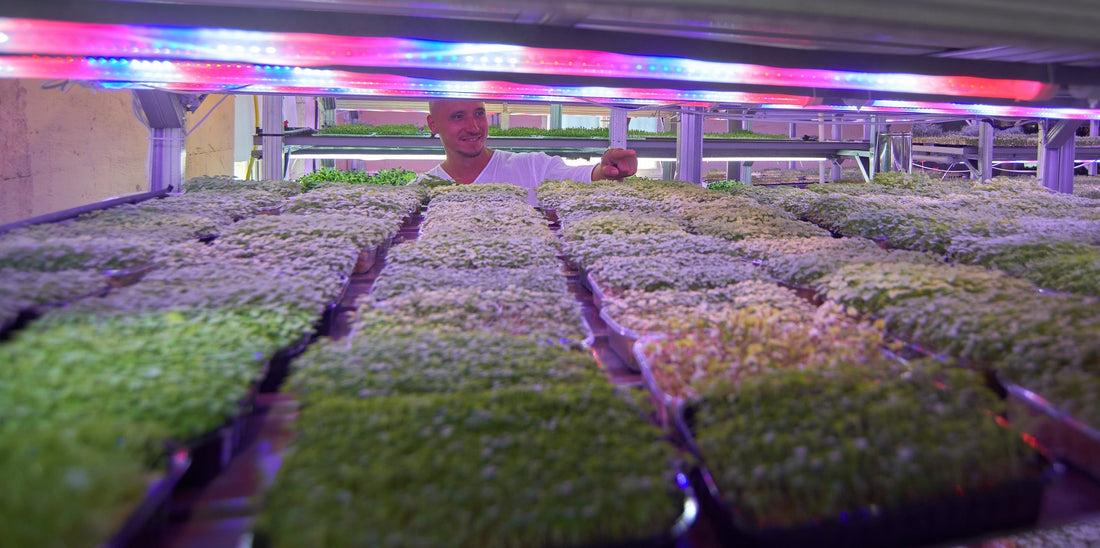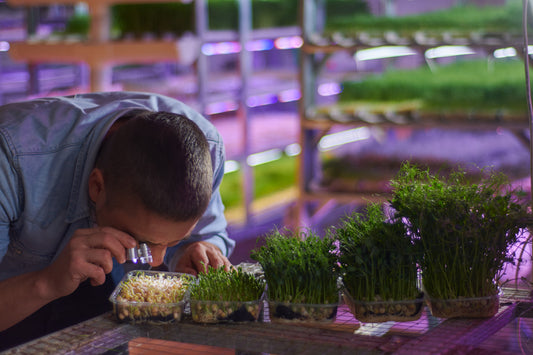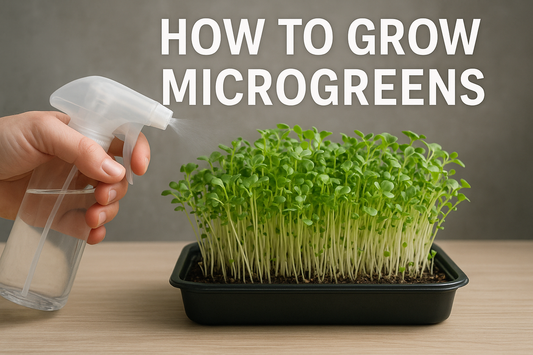
How to Grow Microgreens: Secrets of the Optimal Microclimate for Beginners and Pros
Share
Hello, friends! Today we’ll discuss how to create the ideal conditions for growing microgreens. A properly managed microclimate is the key to obtaining fresh, aromatic, and nutritious sprouts that will not only decorate your table but also help earn your clients’ trust. In this article, we will take a detailed look at four essential aspects: temperature, humidity, ventilation, and lighting.
1. Temperature Regime
Cold-Tolerant Crops
This group includes:
- Crops: Sunflower, pea, alfalfa, radish, mustard, onion, beet, cilantro;
- Cabbage Varieties: Broccoli, red cabbage, kohlrabi, white cabbage, savoy, etc.;
- Additionally: Dill, cumin, fennel, mizuna.
Optimal Conditions:
- At Night: 16–19 °C
- During the Day: 18–20 °C
Notes: These plants can withstand short-term temperature drops down to +10 °C and rises up to 33 °C, but abrupt changes can cause stress resulting in:
- Growth arrest (“the plant stops growing”).
- Disease onset – sudden temperature shifts lower the plants’ immunity, making them vulnerable to fungi and mold.
- During germination, if seeds are densely sown in a hot environment, the heat produced by sprouting combined with ambient high temperature may “burn” the seeds.
- Drafts or sudden temperature drops can damage the edge seedlings.
Warm-Loving Crops
This group includes:
- Crops: Basil, arugula, amaranth, watercress, nasturtium, salad greens;
- Additionally: Borage (cucumber herb), tarragon.
Optimal Conditions:
- At Night: 20–21 °C
- During the Day: 22–25 °C
Notes: These plants do not tolerate temperatures below 18 °C well, which is especially detrimental for basil, arugula, and amaranth.
Temperature Issues and Control Methods
- Stress from Fluctuations: A sharp temperature jump (for example, 18 °C at night vs. 24 °C during the day) can lead to growth arrest, reduced immunity, and fungal diseases.
- Overheating during Germination: Dense seeding combined with heat from sprouting in a hot room can “burn” the seeds.
- Adverse Effects of Drafts: A drop in temperature combined with a draft can negatively impact the edge seedlings.
How to Control Temperature:
- Equipment: Use a microclimate system or an electronic thermostat integrated into the heating system.
- Monitoring Fluctuations: The ideal temperature difference is 3–4 °C; avoid differences exceeding 6 °C between night and day.
-
Antistress Agents: In cases of significant fluctuations, consider using:
- Organic Options: HB101.
Conclusion:
For most crops, the optimal temperature is 18 °C at night and 21 °C during the day, with 21–23 °C being ideal for germination to ensure a quick and healthy start.
2. Air Humidity
Optimal Humidity Level
For growing microgreens indoors, the optimal humidity is between 60–80%, with a target value around 70%.
Humidity-Related Problems
-
Excess Humidity:
- Plants remain constantly wet, fostering fungal diseases and mold.
- They require infrequent watering, leading to a weak root system and visible yellowing of roots.
-
Insufficient Humidity:
- The outer plants begin to dry out and require frequent watering.
- Germinating seeds show dried root tips, and leaves appear weak and less “meaty.”
- Lack of moisture can lead to frequent rot and mold – weaker sprouts die and begin to decay even after watering.
Methods to Regulate Humidity
-
To Increase Humidity:
- Use a humidifier.
- Reduce the intensity of air exchange (lower intake or exhaust).
- Place open water reservoirs in the growing area and near heat sources.
- Mist the plants several times a day.
-
To Decrease Humidity:
- Use a dehumidifier.
- Increase air exchange (enhance intake or exhaust).
- Seal water reservoirs.
- Reduce watering frequency – water more thoroughly but less often, minimizing misting.
Conclusion:
Keep a close eye on humidity and maintain it at an average of around 70%.
3. Plant Breathing and Ventilation
The Importance of Ventilation
Continuous air exchange is vital for microgreens. When air is stagnant, plants “suffocate,” increasing local humidity and creating favorable conditions for fungus and mold.
Potential Ventilation Issues
-
Poor Airflow:
- In the depths of the box or behind its edges, stagnant air can lead to localized fungus, mold, and disease.
- In these areas, microgreens grow poorly and dry out slowly.
-
Excessive Airflow:
- Strong airflow can cause plants to dry out quickly – the first ones may dry out, necessitating more frequent watering.
- A strong breeze may cause the stems to lean, negatively affecting the product’s appearance.
How to Ensure Proper Air Exchange
-
Ventilation System:
- Set up a supply-exhaust ventilation system so that fresh air evenly replaces stale air. Imagine the air flowing “like thick oil” – slowly and uniformly.
-
Additional Equipment:
- Use moving fans (desktop, floor-standing, or suspended). Their advantage is low power and gentle airflow that does not damage delicate greens.
Conclusion:
Air circulation is key to healthy microgreens. Ensure there are no stagnant air zones and avoid excessive airflow that might dry out the plants.
4. Lighting
The Role of Light in Growing Microgreens
Light is one of the most important factors affecting the growth, flavor, and appearance of microgreens. An ideal light period ranges from 15 to 20 hours per day, with an optimal regime of 15 hours of light and 9 hours of darkness to achieve the best balance between growth and energy consumption.
Light Requirements for Different Crops
- Less Demanding: Pea, sunflower, alfalfa, mustard, radish, mizuna, nasturtium, onion.
- More Demanding: Basil, amaranth, beet, arugula, watercress, and brightly colored varieties.
Signs of Inadequate Lighting
When light is insufficient or of poor quality, you might notice:
- Pale and yellow leaves.
- Elongated stems and small, underdeveloped leaves.
- Leaves that appear thin and “less meaty.”
- Colored crops lose saturation, and aromatic herbs lack a pronounced taste, making plants look unhealthy.
Signs of Good Lighting
Under optimal conditions:
- Stems are short, and leaves are plump, wide, and dense.
- Leaf color is bright and saturated.
- The flavor is vivid, juicy, and full-bodied.
- Plants appear vigorous and confident.
Best Lighting Options for Microgreens
-
Sunlight:
- The best option when weather permits, as it provides the most natural spectrum. However, in greenhouses, maintaining sunlight can be challenging due to drastic temperature and humidity fluctuations (summer temperatures reaching +36 °C in the shade, winter down to –20 °C).
-
Grow Lights (Phytolamps):
- An excellent solution for providing quality light that promotes rapid and vigorous growth. The downside is their high cost and the risk of buying inferior copies.
-
Daylight Lamps (LEDs at 6500 K):
- The optimal choice in terms of price/quality for microgreens. These lamps are ideal for the initial and vegetative stages. Although a red spectrum is needed for flowering and fruiting, the blue spectrum provided is sufficient for microgreens.
Special Note on LED Lights:
- The ideal distance from the lamp to the leaves is no more than 20 cm. However, since microgreens can quickly stretch by 5–10 cm, a middle ground of 20–30 cm is usually chosen.
Comparison:
- Experience shows that grow lights promote faster, more vigorous growth with plump leaves. Under cold-spectrum LED lights, plants may lag by 1–2 days but eventually catch up.
Additional Tips for Light Equipment Maintenance
- Regular Cleaning: During watering and treatments, salts may deposit on the lamps from evaporated water, reducing light output to 10–15%. Regularly wipe the lamps with a mild acidic solution to maintain their efficiency.
Conclusion:
Provide at least 16 hours of light per day, ideally using sunlight first, then grow lights, followed by LED lights with a daylight spectrum, while maintaining an optimal distance of 20–25 cm from the plants.
Conclusion
Creating the ideal microclimate is essential for successfully growing microgreens and achieving high-quality produce. In summary:
-
Temperature:
- For growth – 18 °C at night and 21 °C during the day.
- For germination – an optimum of 21–23 °C.
- Monitor fluctuations (ideally 3–4 °C, maximum 6 °C) and use antistress agents if necessary.
-
Humidity:
- An optimum of 60–80%, targeting around 70%.
- Regulate with humidifiers or dehumidifiers and adjust watering frequency accordingly.
-
Ventilation:
- Ensure even air circulation using a supply-exhaust system and additional fans.
-
Lighting:
- Maintain a regime of 15 hours of light/9 hours of darkness (or at least 16 hours of light).
- Prefer sunlight, then grow lights, and finally LED lights (6500 K) while keeping a distance of 20–25 cm from the plants.
By following these guidelines, you will create optimal conditions for growing microgreens, improve product quality.











